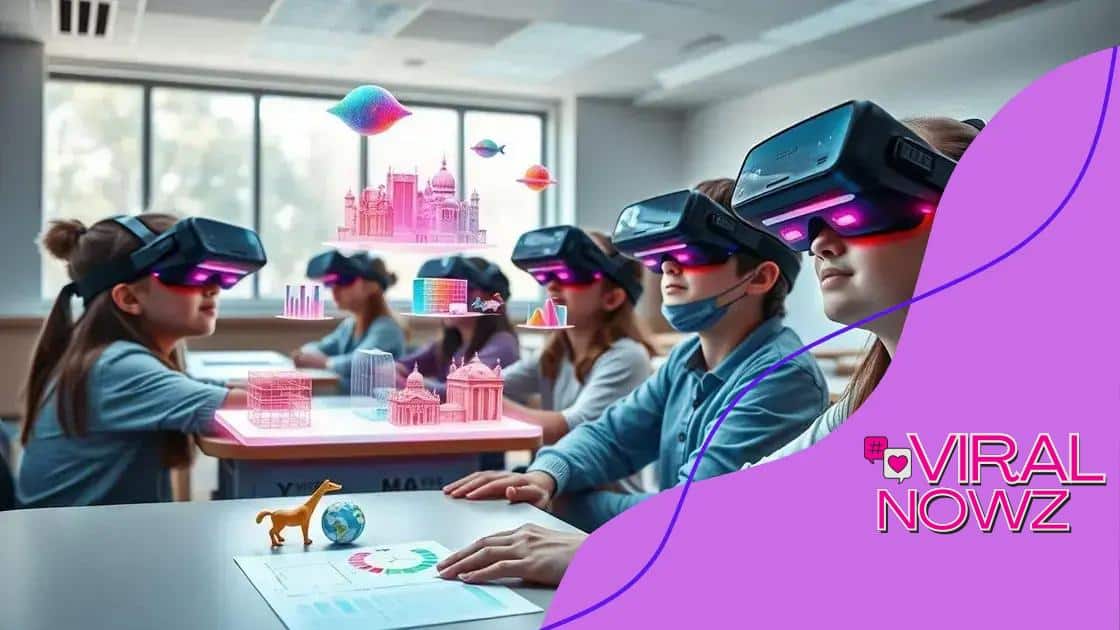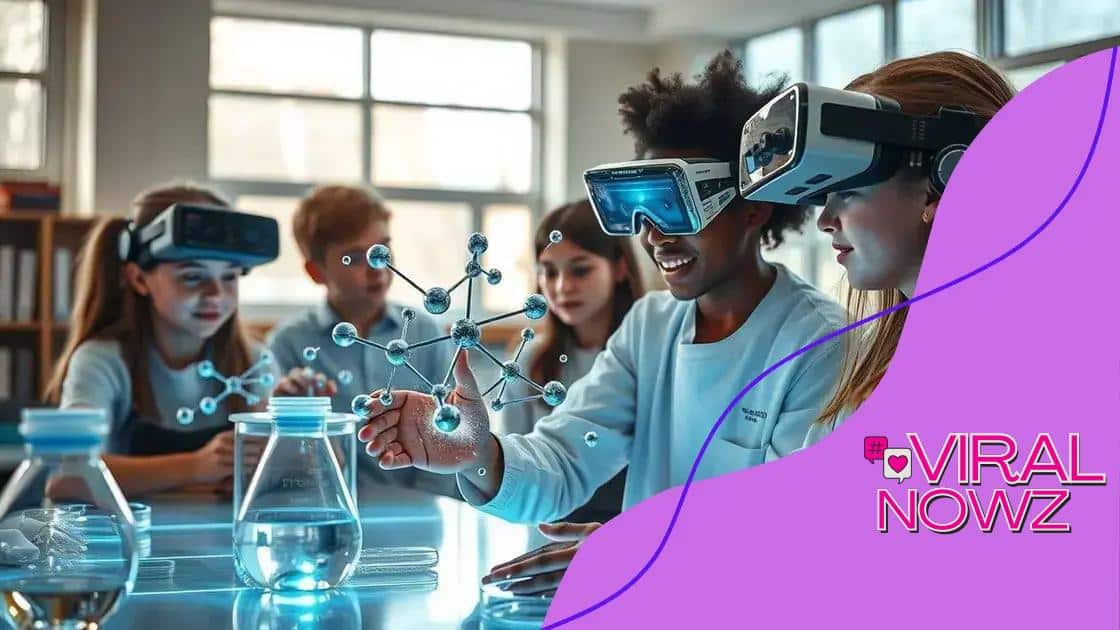How AR is being used for hands-on learning experiences

Augmented reality is transforming education by providing immersive, interactive learning experiences that enhance student engagement and understanding across various subjects, including science, history, and language learning.
How AR is being used for hands-on learning experiences is reshaping education as we know it. Imagine students exploring complex subjects through interactive visuals and simulations. This article delves into the transformative power of AR in learning.
Understanding augmented reality in education
Understanding augmented reality in education is essential for grasping its impact and potential. It offers unique ways to enhance the learning experience by blending digital content with the real world. This powerful tool can transform how students engage with material, making lessons interactive and immersive.
The Concept of Augmented Reality
Augmented reality overlays digital information onto our real-world view, allowing learners to explore information in a new dimension. For example, students can see 3D models of historical artifacts or biological processes right in their classrooms. This method not only boosts understanding but also keeps students interested.
Benefits of Augmented Reality in Classrooms
The advantages of augmented reality in classrooms are numerous. Here are a few key benefits:
- Enhanced Engagement: Students are more engaged and active when learning through AR.
- Improved Retention: Interactive experiences aid in better information retention.
- Access to Complex Concepts: AR simplifies difficult subjects, making them easier to grasp.
- Creative Learning: Students can express their creativity by interacting with content in innovative ways.
In practical settings, augmented reality can be used for various subjects. Imagine science classes where learners can conduct virtual experiments without any risk, or history lessons featuring interactive timelines that students can explore. Furthermore, AR applications can cater to different learning styles, ensuring that all students find engagement and understanding in their unique ways.
Not only does augmented reality enhance traditional learning, but it also prepares students for future careers in technology-driven environments. Employers increasingly seek candidates who can adapt to new technologies and utilize them effectively. Therefore, introducing AR early in education cultivates essential skills that are becoming more relevant in today’s job market.
Benefits of AR for hands-on learning
The benefits of augmented reality for hands-on learning are remarkable. This technology creates immersive experiences that actively engage students in their education. When learners interact with 3D models, they develop a deeper understanding of complex concepts.
Key Advantages of Augmented Reality
One significant advantage of AR is its ability to provide practical experiences. Students can practice skills in a safe environment, allowing them to make mistakes without real-world consequences. This hands-on approach caters to various learning styles, enhancing comprehension.
- Increase in Student Engagement: Learners are more focused and interested when using AR tools, which makes learning enjoyable.
- Enhanced Visualization: Difficult ideas become clearer as students can visualize them in 3D, promoting better understanding.
- Encouragement of Collaboration: Augmented reality often involves group activities, encouraging teamwork and social skills.
- Immediate Feedback: AR applications provide instant responses, helping students adjust their learning strategies quickly.
Furthermore, augmented reality encourages creativity. Students are not just passive recipients of information; they become active creators. By modifying and interacting with digital content, they explore their unique perspectives and enhance their problem-solving abilities.
As the educational landscape evolves, integrating AR into curricula prepares students for future careers where technology plays a central role. Understanding how to use advanced tools is vital in today’s job market, and AR offers an engaging way for students to acquire and practice these essential skills.
How AR enhances science experiments

How augmented reality enhances science experiments is a game changer in education. By integrating AR into the science curriculum, students can conduct virtual experiments that are both safe and engaging. This technology lets them interact with scientific concepts in new ways, making learning feel more relevant and exciting.
Experiencing Science in 3D
One of the main advantages of AR in science education is the ability to visualize complex processes. With augmented reality, students can see atomic structures, chemical reactions, or even the processes that occur in the human body as 3D models. This visualization leads to better understanding and retention of information.
- Interactive Learning: Students engage in hands-on activities that promote exploration and inquiry.
- Safe Experimentation: AR allows students to conduct experiments that would be too dangerous or expensive in real life.
- Instant Feedback: Students can learn from their mistakes quickly, allowing for a deeper grasp of scientific concepts.
- Collaboration Opportunities: Many AR applications encourage teamwork, helping students work together and share ideas.
In addition, augmented reality can simulate real-world scenarios. For instance, biology students can examine living organisms in a detailed manner without having to use actual specimens. This not only saves resources but also ensures that all students can have equal access to learning materials.
Furthermore, AR can cater to diverse learning preferences. Visual learners can benefit from 3D visualizations, while kinesthetic learners can interact with virtual materials. By offering varied learning experiences, teachers can meet the needs of all students, enhancing their understanding of science.
Real-world applications of AR in classrooms
Real-world applications of augmented reality in classrooms are transforming education dramatically. This technology provides teachers and students with unique tools to enhance learning experiences. By integrating AR into various subjects, classrooms become more interactive and engaging.
Examples of Augmented Reality Usage
Many educators are already using augmented reality in innovative ways. For instance, history teachers can use AR applications to bring historical events to life. Students can point their devices at specific landmarks and see information or 3D models of significant events that took place there.
- Interactive Textbooks: Some textbooks come with AR features that allow students to scan pages and access videos or supplemental material, providing a richer educational experience.
- Virtual Field Trips: Students can explore remote locations around the world without leaving their classrooms. AR provides immersive experiences that give them insight into different cultures and environments.
- Science Simulations: In science class, students can visualize complex systems like the solar system or human anatomy in a 3D environment, enhancing their understanding of these subjects.
- Language Learning: AR apps can help language learners practice vocabulary by associating words with images and interactive elements, making memorization easier.
These applications not only make learning more enjoyable but also improve knowledge retention. When students interact with content in a dynamic way, they are more likely to remember what they’ve learned. Additionally, AR encourages collaboration among students as they work together on projects and discover concepts in engaging ways.
Another benefit of augmented reality in classrooms is that it caters to different learning styles. Visual learners can benefit from 3D imagery, while kinesthetic learners can engage actively with AR tools. This creates an inclusive environment, enhancing the overall educational experience.
Future trends of AR in education
The future trends of augmented reality in education are exciting and full of potential. As technology advances, AR is poised to transform how students learn and interact with information. The integration of AR in classrooms is just beginning, and many innovative developments are on the horizon.
Emerging Technologies
One major trend is the growth of mobile AR applications. As smartphones and tablets become more powerful, educational apps will leverage augmented reality to create rich learning experiences. Students will be able to access interactive lessons anytime, anywhere. This flexibility can enhance the learning environment significantly.
- Increased Personalization: Future AR tools will enable personalized learning experiences tailored to individual student needs and learning styles.
- AI Integration: Combining AR with artificial intelligence can provide adaptive learning paths, making the educational experience even more engaging.
- Collaborative Learning: As AR technology improves, opportunities for collaborative projects among students through AR will increase, fostering teamwork and communication skills.
- Integration with Virtual Reality: The fusion of AR with VR will create even more immersive educational experiences, allowing students to explore new worlds and scenarios.
Furthermore, as educators become more familiar with augmented reality, curriculum development will adapt to include AR-based learning. This could lead to a shift in teaching methods, focusing on experiential learning rather than traditional lectures. Students will learn through exploration and interactive simulations, giving them the freedom to engage with subjects in their unique ways.
The use of AR in assessments is another upcoming trend. Teachers may utilize AR for interactive quizzes and exams, providing immediate feedback that helps students understand their strengths and areas for improvement. This approach not only motivates learners but also equips them with critical thinking skills.
FAQ – Frequently Asked Questions about Augmented Reality in Education
How does augmented reality enhance learning experiences?
Augmented reality engages students by providing interactive and immersive learning experiences, making complex subjects easier to understand.
What are some real-world applications of augmented reality in classrooms?
AR is used for interactive textbooks, virtual field trips, science simulations, and language learning, allowing students to engage with content dynamically.
What future trends can we expect for augmented reality in education?
Future trends include increased mobile AR applications, personalized learning experiences, integration with AI for adaptive learning, and collaborative projects.
How can augmented reality facilitate collaboration among students?
AR promotes teamwork by allowing students to work together on interactive projects, enhancing their social skills and encouraging group problem-solving.





